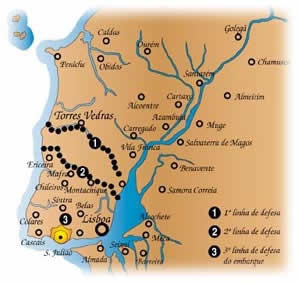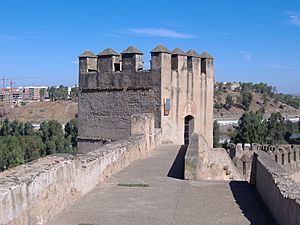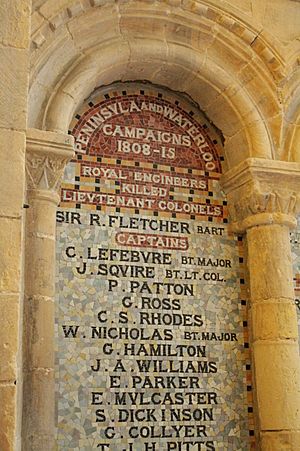Sir Richard Fletcher, 1st Baronet facts for kids
Quick facts for kids
|
|
|---|---|
 |
|
| Born | 1768 |
| Died | 31 August 1813 San Sebastián |
| Allegiance | United Kingdom |
| Service/ |
British Army |
| Rank | Lieutenant Colonel |
| Battles/wars | Battle of Martinique (1794) Battle of Copenhagen (1807) Battle of Talavera Battle of Buçaco Battle of Sabugal Battle of Fuentes de Oñoro Second Siege of Badajoz (1811) Siege of Ciudad Rodrigo (1812) Battle of Vitoria Siege of Badajoz (1812) Siege of Pamplona (1813) Siege of San Sebastian |
Sir Richard Fletcher (born in 1768, died August 31, 1813) was a brave engineer in the British Army. He is famous for building the amazing Lines of Torres Vedras, which were strong defenses in Portugal. He fought in important wars like the French Revolutionary Wars and the Peninsular War. Richard Fletcher was recognized many times for his courage in battles such as Talavera, Busaco, Badajoz, and Vitoria. He was hurt twice while fighting and sadly died in battle during the Siege of San Sebastian.
Contents
Richard Fletcher's Early Life
Not much is known about Richard Fletcher's early life. We know he was born in 1768, and his father was a clergyman, which is a religious leader.
On November 27, 1796, he married Elizabeth Mudge in Plymouth. She was the daughter of a doctor. Richard and Elizabeth had five children together: two sons and three daughters.
Even though Fletcher was buried near where he died in San Sebastián, there is a special monument to him. This memorial, paid for by the Royal Engineers, stands in Westminster Abbey in London.
Starting His Military Career
Richard Fletcher began his military training at the Royal Military Academy in Woolwich on October 7, 1782. He first joined the Royal Artillery and became a second-lieutenant in 1788.
Then, in 1790, he joined the Royal Engineers, a group of soldiers who are experts in building and design. He was promoted to lieutenant in 1793. When France declared war on Britain later that year, Fletcher was sent to serve in the West Indies.
Fighting in the French Revolutionary Wars
While in the West Indies, Fletcher helped the British attack and capture French colonies. These included Martinique, Gaudeloupe, and St Lucia in 1794. During the capture of St Lucia, he was shot and wounded.
After that, Fletcher was moved to the British island of Dominica. He became the chief engineer there before returning home to England in late 1796.
Back in England, Fletcher worked in Portsmouth until December 1798. Then, he was sent to Constantinople (which is now Istanbul) to advise the Ottoman Government. He planned to travel through Hanover, but his ship crashed near the Elbe river. Fletcher had to walk two miles across ice to reach land.
After three months of travel, he arrived in Constantinople in March 1799. In June 1799, Fletcher joined Ottoman troops in Syria. They forced Napoleon to stop his attack on Acre and retreat to Egypt.
Later in 1799, Fletcher helped prepare defenses for the Turks in the Dardanelles. He also spent time with Ottoman forces in Cyprus. In June 1800, he returned to Syria to build forts at Jaffa and El Arish.
In December 1800, Fletcher worked with Sir Ralph Abercromby at Marmaris Bay. They practiced beach assaults for a planned invasion of Egypt. Fletcher was captured during a scouting mission in Alexandria. He was held prisoner until the city was captured by the British in September 1801.
In October 1801, a peace agreement was signed, and Fletcher returned to England. He had been promoted to captain while imprisoned and received an award from the Ottoman Empire. Peace did not last long, and war started again in May 1803. Fletcher was sent back to Portsmouth to help strengthen the defenses of Gosport. He was promoted to major in 1807 and fought in the Battle of Copenhagen that August.
The Peninsular War Begins
Soon after the Peninsular War started, Fletcher was sent to Portugal. He was part of the army that took over Lisbon when the French left. After this, he became the chief engineer for Wellington, a very important British general.
Fletcher was promoted to lieutenant-colonel in the army in 1809, and then in the Royal Engineers. He fought bravely at the Battle of Talavera in July 1809. For his actions there, he was specially mentioned in official reports.
Building the Lines of Torres Vedras
Richard Fletcher became famous for one of the greatest military engineering projects ever. This was the building of the Lines of Torres Vedras. These were strong defense lines built on a narrow piece of land between the Atlantic Ocean and the Tagus River.
There were three main lines of defense. The first was six miles in front of the main one, and the last was 20 miles behind it. Their purpose was to protect Lisbon and give the British army a safe way to retreat to their ships if needed.
Fletcher started building these defenses in October 1809. He used many Portuguese soldiers and civilians to do the hard work. They made rocky slopes steeper and stronger. They blocked narrow passages with forts and earthworks. Trees and plants were removed so the enemy had no cover or food. Rivers were blocked to create lakes or swamps that the enemy could not cross. Any buildings were either made into forts or destroyed.
Forts guarded every path, and cannons were placed on high ground. A system of signal stations and roads made sure that troops could be sent quickly to where they were most needed. All of this was done in great secrecy. Even Napoleon and the British Government did not know about these lines until Wellington had to retreat behind them later that year.
In July 1810, just before the lines were finished, Fletcher left the forts to fight alongside Wellington again. He was at the Battle of Buçaco in September 1810, where he again showed great skill and was mentioned in reports.
Wellington's army moved back to the Lines of Torres Vedras in October 1810. Marshal Masséna and his French army followed them. Masséna was shocked to find such strong defenses. He had been told by Portuguese rebels that the road to Lisbon would be easy. Wellington's leaders were also surprised when they heard about the defenses.
After an unsuccessful attack in October, Masséna first retreated to Santarém. But when his supplies ran out the next March, he gave up on trying to reach Lisbon and headed north.
Later Military Campaigns
Fletcher, as part of Wellington's forces, chased Masséna to Sabugal. After some small fights, Masséna was finally forced into a big battle at Battle of Sabugal on April 2. This was one of many battles as Wellington and Masséna fought for control along the border between Portugal and Spain.
After forcing Masséna to leave Sabugal, Wellington focused on Almeida and Ciudad Rodrigo. These were two fortresses that guarded the northern way into Portugal. Wellington had planned to capture both while Masséna's army was still disorganized. However, the loss of Badajoz to Marshall Soult in March, which protected the south, forced Wellington to split his army.
Wellington sent a quarter of his troops to help General Beresford retake Badajoz. His remaining force, which included Fletcher, would attack Almeida. Masséna, now with a larger army, marched to help Almeida. Wellington did not want to fight under those conditions, so he moved his army to Fuentes d'Onoro.
The town changed hands many times during a battle that lasted three days (May 3–5). But in the end, it stayed under British control. Masséna's troops could not reach the fort or stay in the open, so they were forced to leave on May 8. Wellington continued his attack and took Almeida two days later.
Fletcher was again mentioned in reports for his work as chief engineer at the second siege of Badajoz (May 19 – June 10, 1811). The engineers suffered many injuries trying to dig through the thin, rocky soil around the fort. The fort had been repaired and made stronger since the last failed attack.
Wellington's army was running low on ammunition and had lost many soldiers. With news that French reinforcements were coming, Wellington pulled his forces back on June 10.
Fletcher was also present when Ciudad Rodrigo (January 7–19, 1812) and, on the third try, Badajoz (March 17 – April 16, 1812) were captured. In the attack on Badajoz, Fletcher found the weak spot in the defenses. This helped decide where the main attack should be.
On March 19, Fletcher was shot in the groin when French soldiers attacked in the fog. His injury could have been much worse if it had not been for a Spanish Silver Dollar in his pocket, which took most of the force from the musket ball.
Fletcher's injury kept him in his tent. Wellington, who desperately needed good engineers, visited him daily for advice. Fletcher returned to England to recover. He was made a baronet (a special title) in December 1812 and received a pension of £1.00 per day. He also received the Portuguese award of the Order of the Tower and Sword. He was given the Army Gold Cross for his bravery at Talavera, Bussaco, Ciudad Rodrigo, and Badajoz.
Fletcher returned to the Peninsular War in 1813. He was again mentioned in reports for his role in the Battle of Vitoria on June 21. Fletcher led the attacks on Pamplona and San Sebastián. He was killed in action during the final attack on San Sebastián on August 31, 1813.
Memorials to Sir Richard Fletcher
Sir Richard Fletcher is remembered on a special panel in Rochester Cathedral. This panel honors those who died in the Peninsular War.
There is also a memorial to him in Westminster Abbey, which was created by the sculptor Edward Hodges Baily.





